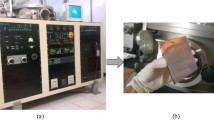Abstract
The high pressure radio frequency plasma enhanced chemical vapor deposition (RF-PECVD) process was adopted to prepare the n-i-p microcrystalline silicon solar cells, the influence of p-type layers on the performance of the solar cells was investigated, and the optimum p layer suited to the n-i-p microcrystalline silicon solar cells was obtained. The experimental results demonstrate that the performance of the solar cells can be highly affected by the structural and optical properties of the p-layers, and the performance of solar cells can be greatly improved by optimizing p layers. We have achieved an initial active-area efficiency of 8.17% (V oc=0.49 V, J sc=24.9 mA/cm2, FF=67%) for the μc-Si:H single-junction n-i-p solar cells and an initial active-area efficiency of 10.93% (V oc=1.31 V, J sc=13.09 mA/cm2, FF=64%) for the a-Si:H/μc-Si:H tandem n-i-p solar cells.
Similar content being viewed by others
Referenes
Meier J, Dubail S, Platz R, et al. Towards high-efficiency thin-film silicon solar cells with the “micromorph” concept. Sol Energy Mater Sol Cells, 1997, 49(1–4): 35–44
Vetterl O, Finger F, Carius R, et al. Intrinsic microcrystalline silicon: A new material for photovoltaics. Sol Energy Mater Sol Cells, 2000, 62(1–2): 97–108
Droz C, Vallat-Sauvain E, Bailat J, et al. Relationship between Raman crystallinity and open-circuit voltage in microcrystalline silicon solar cells. Sol Energy Mater Sol Cells, 2004, 81: 61–71
Rath J K, Schropp R E I. Incorporation of p-type microcrystalline silicon films in amorphous silicon based solar cells in a superstrate structure. Sol Energy Mater Sol Cells, 1998, 53: 189–203
Zhu F, Zhao Y, Wei C, et al. The effect of P layer’s crystallization on microcrystalline silicon solar cell. 20th European photovoltaic Solar Energy Conference and Exhibition, 2005, 3DV.3.6
Vetterl O, Hulsbeck M, Wolff J, et al. Preparation of microcrystalline silicon seed-layers with defined structural properties. Thin Solid Films, 2003, 427: 46–50
Li Y, Li L, Selvan J A, et al. Effects of seeding methods on the fabrication of microcrystalline silicon solar cells using radio frequency plasma enhanced chemical vapor deposition. Thin Solid Films, 2005, 483: 84–88
Demichelis F, Pirri C F, Tresso E. Influence of doping on the structural and optoelectronic properties of amorphous and microcrystalline silicon carbide. J Appl Phys, 1992, 72(4): 1327–1333
Das D, Jana M. Development of highly conducting p-type μc-Si:H films from minor diborane doping in highly hydrogenated SiH4 plasma. Mater Lett, 2004, 58: 980–985
Yan B, Owens J M, Yang J, et al. High efficiency triple-junction solar cells with hydrogenated nanocrystalline silicon bottom cell. Conference Record of the 31st IEEE Photovoltaic Specialist Conference, 2006, 1456–1459
Zi J, Buscher H, Falter C, et al. Raman shifts in Si nanocrystals. Appl Phys Lett, 1996, 69: 200–202
He Y L, Chen G H, Zhang F Q. Physics of Amorphous Semiconductors. Beijing: Higher Education Press, 1989
Chen Z M. Amorphous Semiconductor Materials and Devices. Beijing: Science Press, 1991
Luo J S, Rong A L. Amorphous Semiconductors. Xi’an: Xi’an Jiaotong University Press, 1986
Hu Z H, Liao X B, Diao H W, et al. Hydrogenated p-type nanocrystalline silicon in amorphous silicon solar cells. J Non-Crystall Solids, 2006, 352: 1900–1903
Du W H, Liao X B, Yang X S, et al. Hydrogenated nanocrystalline silicon p-layer in amorphous silicon n-i-p solar cells. Sol Energy Mater Sol Cells, 2006, 90: 1098–1104
Author information
Authors and Affiliations
Corresponding author
Rights and permissions
About this article
Cite this article
Yuan, Y., Zhang, K., Wei, Z. et al. Influence of p-layer on the performance of n-i-p μc-Si:H thin film solar cells. Sci. China Phys. Mech. Astron. 53, 2042–2046 (2010). https://doi.org/10.1007/s11433-010-4143-6
Received:
Accepted:
Published:
Issue Date:
DOI: https://doi.org/10.1007/s11433-010-4143-6




